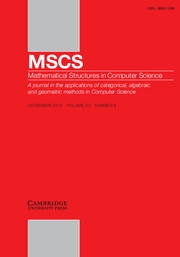Crossref Citations
This article has been cited by the following publications. This list is generated based on data provided by
Crossref.
Gaucher, Philippe
2000.
From Concurrency to Algebraic Topology.
Electronic Notes in Theoretical Computer Science,
Vol. 39,
Issue. 2,
p.
1.
Gaucher, Philippe
2001.
Combinatorics of branchings in higher dimensional automata.
Theory and Applications of Categories,
Vol. 08,
Issue. ,
p.
324.
Goubault, Éric
and
Raussen, Marti
2002.
LATIN 2002: Theoretical Informatics.
Vol. 2286,
Issue. ,
p.
16.
Buckland, Richard
Johnson, Michael
and
Verity, Dominic
2002.
On the Specification of Higher Dimensional Automata
.
Electronic Notes in Theoretical Computer Science,
Vol. 68,
Issue. 1,
p.
1.
Ali Al-Agl, Fahd
Brown, Ronald
and
Steiner, Richard
2002.
Multiple Categories: The Equivalence of a Globular and a Cubical Approach.
Advances in Mathematics,
Vol. 170,
Issue. 1,
p.
71.
Grandis, Marco
2002.
Directed homotopy theory, II. Homotopy constructs .
Theory and Applications of Categories,
Vol. 10,
Issue. ,
p.
369.
Gaucher, Philippe
2002.
Investigating the Algebraic Structure of Dihomotopy Types.
Electronic Notes in Theoretical Computer Science,
Vol. 52,
Issue. 2,
p.
139.
Métayer, François
2003.
Resolutions by Polygraphs.
Theory and Applications of Categories,
Vol. 11,
Issue. ,
p.
148.
Gaucher, Philippe
2003.
The branching nerve of HDA and the Kan condition.
Theory and Applications of Categories,
Vol. 11,
Issue. ,
p.
75.
Brown, Ronald
and
Porter, Timothy
2003.
The intuitions of higuer dimensional algebra for the study of structured space.
Revue de Synthèse,
Vol. 124,
Issue. 1,
p.
173.
Grandis, Marco
and
Mauri, Luca
2003.
Cubical sets and their site.
Theory and Applications of Categories,
Vol. 11,
Issue. ,
p.
185.
Gaucher, Philippe
2003.
Automate parallèle à homotopie près (I).
Comptes Rendus. Mathématique,
Vol. 336,
Issue. 7,
p.
593.
van Glabbeek, R.J.
2005.
On the Expressiveness of Higher Dimensional Automata.
Electronic Notes in Theoretical Computer Science,
Vol. 128,
Issue. 2,
p.
5.
van Glabbeek, R.J.
2006.
On the expressiveness of higher dimensional automata.
Theoretical Computer Science,
Vol. 356,
Issue. 3,
p.
265.
Fajstrup, Lisbeth
Raußen, Martin
and
Goubault, Eric
2006.
Algebraic topology and concurrency.
Theoretical Computer Science,
Vol. 357,
Issue. 1-3,
p.
241.
Gaucher, Philippe
2010.
Combinatorics of labelling in higher-dimensional automata.
Theoretical Computer Science,
Vol. 411,
Issue. 11-13,
p.
1452.
Fahrenberg, Uli
and
Legay, Axel
2013.
History-Preserving Bisimilarity for Higher-Dimensional Automata via Open Maps.
Electronic Notes in Theoretical Computer Science,
Vol. 298,
Issue. ,
p.
165.
Pop, I.
2021.
Directed approximate fibrations.
Annals of the Alexandru Ioan Cuza University - Mathematics,
Vol. 67,
Issue. 2,
p.
331.

